A Complete History of the British Pound Coin
12/04/2024Daniel Fisher
Free & fully insured UK Delivery. Learn more
Secure & flexible payments. Learn more

Buyback Guarantee Learn more
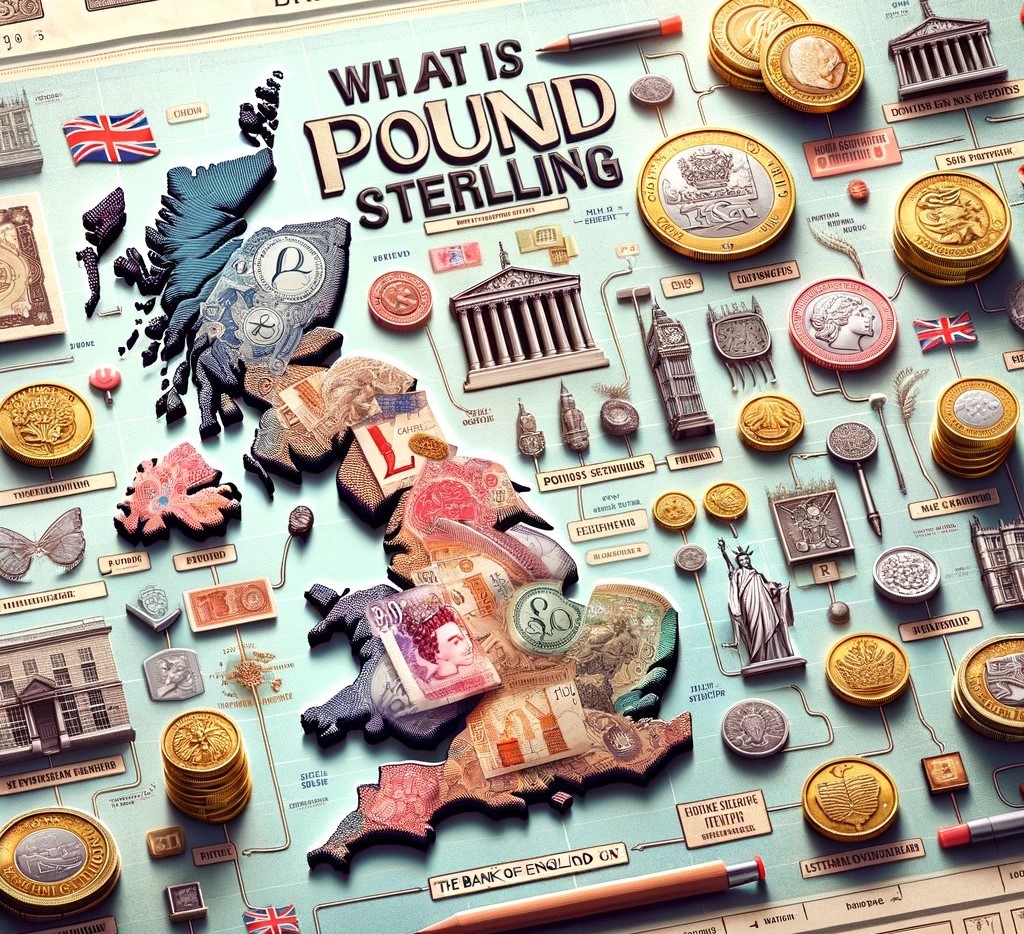
The Pound Sterling (GBP) is the official currency of the United Kingdom, encompassing England, Scotland, Wales, and Northern Ireland. It serves as the medium of exchange for goods and services within the UK and is recognized internationally as one of the major currencies in the global financial system.
With its origins dating back to the Anglo-Saxon period, the Pound Sterling holds the distinction of being one of the oldest continuously used currencies in the world. It is denoted by the symbol “£” and subdivided into 100 smaller units known as pence.
Issued and regulated by the Bank of England, the Pound Sterling exists in both coin and banknote forms. The Royal Mint, under the authority of the UK government, mints the coins, while the Bank of England prints the banknotes. Presently, the Pound Sterling is available in various denominations, ranging from the familiar £1 coin to the higher denominations such as £5, £10, £20, and £50 notes.
Internationally, the Pound Sterling holds significance as the fourth most commonly traded currency in the foreign exchange market, reflecting its importance in global trade and finance. The renowned currency embodies the economic stability and heritage of the United Kingdom, playing a pivotal role in domestic and international commerce.
The history of the Pound Sterling is steeped in tradition, reflecting centuries of economic evolution and cultural significance. The name “pound” finds its origins in the Latin term “libra,” which was used to denote a unit of weight in the Roman Empire. The use of the term “sterling” can be traced back to medieval England, where it referred to a specific type of silver penny that was considered of high quality.
Although UK the earliest UK coins stretch back to ancient times, the Pound coin, as we recognize it today, was first introduced in 1489 during the reign of Henry VII. These early coins were made of gold and were known as Sovereigns, marking the birth of the popular gold bullion coin we all know today. However, it wasn’t until the introduction of the gold standard in the 19th century that the Pound Sterling truly solidified its place as the standard unit of currency in the United Kingdom.
The issuance of circulating banknotes by the Bank of England began in the late 17th century, with the first notes appearing in 1694. Initially, these notes were handwritten and could be exchanged for gold or silver at the Bank of England. Over time, printed notes became more common, circulating alongside coins as a widely accepted form of currency.
Prior to decimalisation in 1971, the Pound Sterling was divided into twenty shillings, with each shilling further divided into twelve pence. This system, known as pounds, shillings, and pence (LSD), had its roots in medieval England and persisted for centuries. Denominations included the guinea, crown, florin, shilling, and penny, each with its own value and historical significance.
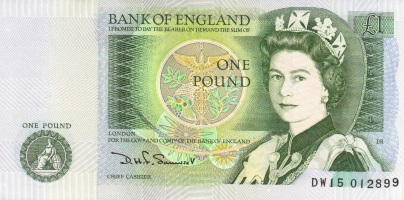
The original one Pound note, in circulation until 1988
1983 was an important year for British coinage. It was the year in which the British pound coin was minted and put into circulation to replace the Bank of England’s one pound note. The pound note saw its last issue at the end of 1984. The note continued to be in circulation until 11th of March 1988. On that date, it was removed from circulation.
Like all other UK banknotes, the pound note remained redeemable at the bank. But, for all official purposes, the pound note had been terminated and replaced with the British pound coin. Interestingly, the Royal Bank of Scotland continued the issue of pound notes. Similarly, the Channel Islands continued to use them as well. But the pound coin gained popularity and eventually became the more widely used form of currency. In this article, we will overview the
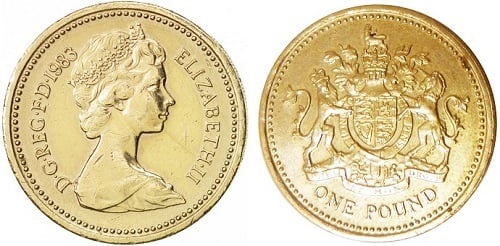
The original 1983 Pound coin featured the Elizabeth Decimal portrait by Arnold Machin
The main reason for the withdrawal of the 1 pound note was its longevity. The British one pound banknote survived in circulation for approximately 9 months only. The Royal Mint found out that after repeated usage, the pound notes would often end up being damaged, or defaced. A pound coin, on the other hand, could remain in circulation for 40 years or more. Therefore, on 31 July 1981, the government announced its intention to replace the one pound note with the one pound coin.
The obverse of the pound coin bears a Latin inscription engraved on it. This inscription reads ‘Elizabeth II D G REG’. The abbreviation stands for the words “Dei Gratia Regina”. The entire inscription, when translated into English means “Elizabeth II, by the Grace of God, Queen and Defender of the Faith”. Since the original release of the pound coin on 21 April 1983, four portraits of the Queen, each different from the other, have been used. The year of the mintage was also engraved alongside the Latin inscription.
The first series of coins released in 1983 used a portrait of Queen Elizabeth the second, which had been created by designer Arnold Machin. This portrait appears on the obverse of the coin and features the Queen wearing a tiara. By 1985, a new portrait of the Queen was used, and it was created by Raphael Maklouf. In this portrait, the Queen is featured wearing the George IV State Diadem. This version of the pound coin was issued till 1997.
From 1998 to 2015, the design of the pound coin was changed yet again. This time, a new portrait created by Ian Rank-Broadley was used. Once again, the Queen’s portrait depicted her wearing a tiara. A makeover of the pound coin took place again in 2015. This time, well-known designer Jody Clark was commissioned to create the design. Her portrait of the Queen was introduced on the pound coin in 2015 and depicts the monarch wearing the George IV State Diadem.
The reverse of the pound coin had its design changed every year since 1983. This was done to ensure the complete representation of England, Scotland, Wales and Northern Ireland, as parts of the UK. Each year, the one pound coin would have a different emblem which represents each geographic area along with an inscription on the edge. The words, “one pound” can be found on the reverse of all these coins.
Free ultimate guide for keen gold investors
Unknown to many, as the round one pound coin gained popularity, counterfeiters took to duplicating this coin. By 2013, there was an estimated 3.04% of counterfeit coins in circulation. The geographical areas that had the maximum number of counterfeit coins were Northern Ireland, the South-East of England and the City of London. Coin testing companies were commissioned by the Royal Mint to study the problem. The coin testing professionals found out that the actual number was approximately twice that estimated by the Royal Mint.
Frequently banks did not check the coins they were receiving. As a result, many banks were also inundated with counterfeit currency. The experts detected that many counterfeit coins had poor quality, along with marked visual differences in design. Of course, there were more sophisticated counterfeiters, that would require a specialised machine to detect.
The last batch of the British round one pound coins was minted in December 2015. The 12 edge coin that has replaced it is a bi-metallic coin whose design makes it harder to duplicate. The coin also has a concealed security feature, which is a code that becomes visible under a certain wavelength of ultraviolet light. There were a few other round pound coins in circulation as well, although these were never legal tender in the UK.
These coins were minted by the British Crown dependencies and Gibraltar, amongst others. They were identical to the one pound coin circulated in the UK and carried the same portraits of the British monarch. Some of these coins have remained in circulation, as these territories have not stopped the mintage of the coins or changed it.
The new one pound coin has a 12 sided, bimetallic structure. This coin was released on 28 March 2017. A design competition was organised with participation from members of the public. This competition was unveiled in 2014 and the results, which were declared in March 2015 named a 15-year-old boy called David Pearce as the winner. The new design featured a rose, thistle, leek and a shamrock, ensconced by a crown.
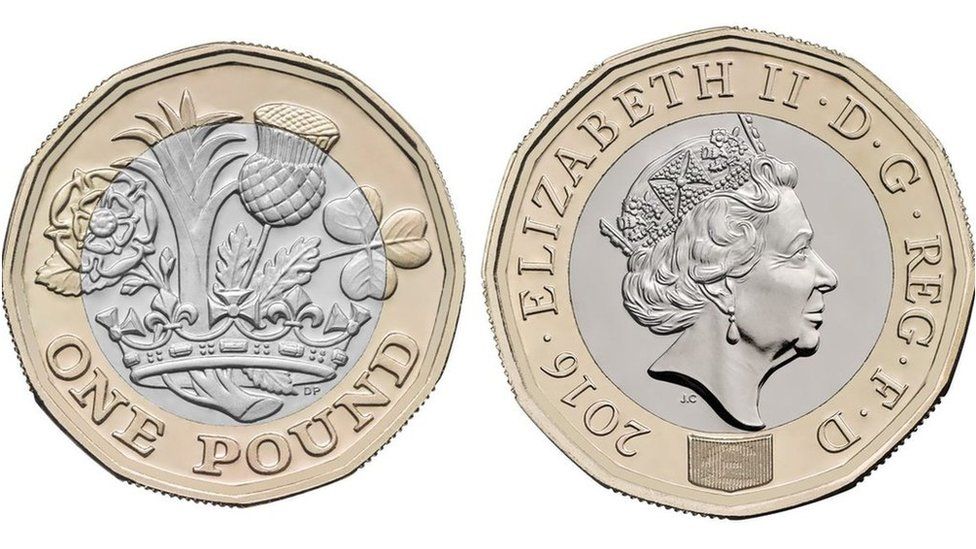
The 12-sided one pound coin was introduced in 2017
After the passing of Queen Elizabeth in 2022, the inauguration of King Charles II as her successor, required all coinage including the Pound coin to be updated.
In 2023, the dodecagonal pound was updated as part of the new UK currency. The same advanced security features, including micro-lettering, latent images, and a hidden security feature, adorn the coin to ensure its authenticity and integrity.
Emblazoned on the obverse of the coin is the portrait of King Charles III, as depicted by designer Martin Jennings. Meanwhile the coin reverse showcases two honey bees on the right, with a honeycomb design to the left. This provides consistency with the entire flora and fauna-themed currency range, celebrating King Charles’ love of nature.
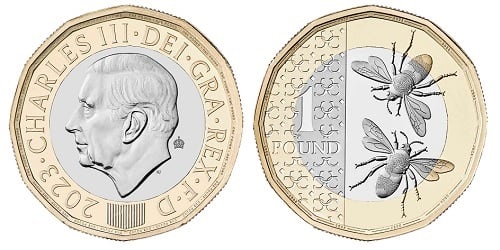
The 2023 King Charles III Pound Coin
Bridging the gap between the standard nickel-brass Pound coin used as circulating currency and the gold Sovereign coin, is the gold one pound coin. These niche coins are minted by the Royal Mint in 22 carat gold as collectible precious metals coins for enthusiasts.
They’re designed to look more like the familiar Pound coin than the standard Sovereign coin size and as such, it is thicker than the Sovereign to feel more like the currency. While the Sovereign weighs 7.98 grams, the gold Pound coin weighs in at a hefty 19.61g and contains around 250% more gold. More recent versions have featured the same 12-sided shape as the standard Pound coin.
Coins are minted to Proof standard, with mintages limited to around 1,500 – 3,000 coins per design and are aimed at commemorating national themes and landmarks.
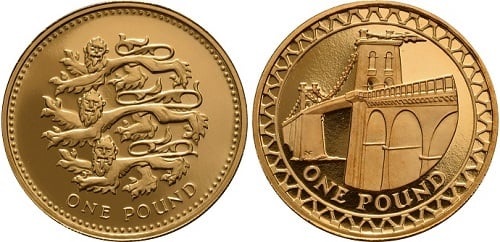
Limited-issue 22-carat gold Pound Coins are minted by the Royal Mint
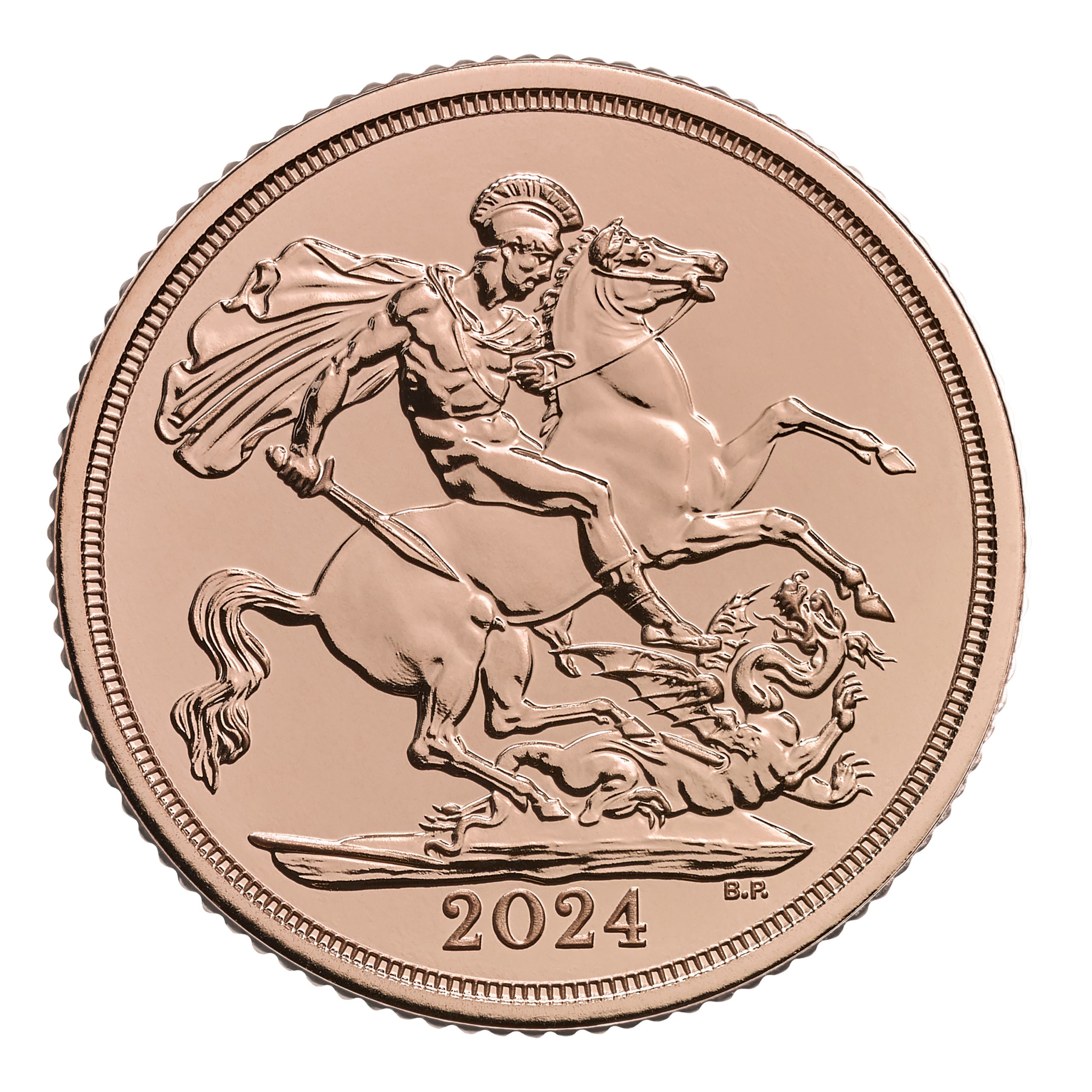
The Gold Sovereign holds a distinguished place in the history of the British currency, symbolizing the power and prestige of the British Empire during its zenith.
First issued during the reign of Henry VII in 1489, the One Pound Gold Sovereign was originally a coin of pure gold, featuring intricate designs and heraldic symbols of the monarchy. These coins were widely circulated throughout the empire, serving as a symbol of Britain’s economic might and global influence, becoming legal tender in the 1817 after the Great Recoinage Act.
Throughout the centuries, the Gold Sovereign acted as the original pound coin, accepted for transactions both domestically and in the far reaches of the British Empire. Its value remained stable due to the intrinsic worth of the gold from which it was minted.
The Gold Sovereign stopped being used as common currency at the start of World War I and was eventually replaced by the one pound banknote. Hand-written one pound notes had been issued as early as 1797 during a three-decade shortage of bullion, but the early 20th century marked the first printed notes. This transition marked a shift towards paper currency backed by the authority of the Bank of England, facilitating larger transactions and providing greater convenience in everyday commerce.
After the decline of the gold standard and the shift towards fiat currency in the 20th century, the Gold Sovereign ceased to be used as common currency in everyday transactions. It was re-issued as legal tender bullion in 1957 and has always maintained its one pound face value. Its role has transitioned from circulating coin to collector’s item and investment asset, valued for its historical significance and the purity of its gold content.
Physical Gold is one of the most reputed precious metal dealers in the UK. We also deal in precious coins and if you want to get an evaluation done, or wish to purchase specific coins of value, please call us on (020) 7060 9992. You can also contact us via email and a member of our customer service team will be happy to call you back.
The British Pound, or Pound Sterling, originated in Anglo-Saxon England, evolving over centuries. It became standardized during the reign of King Henry II in the 12th century, serving as the official currency of England and later the entire United Kingdom.
The term “quid” is believed to have originated from the Latin phrase “quid pro quo,” meaning “something for something.” It became a colloquial term for the Pound in the late 17th century.
In 1992, billionaire investor George Soros famously “broke” the British Pound by betting against it in a speculative attack, forcing the UK to withdraw from the European Exchange Rate Mechanism.
The oldest currency still in use today is the British Pound Sterling, which has been in continuous circulation since the 8th century AD. While it has evolved through its various forms, including the change to decimalization, it remains the oldest and one of the most traded currencies worldwide.
Britain retained the Pound Sterling to maintain control over its monetary policy, preserve national sovereignty, and safeguard its economic interests outside the Eurozone.
The strength of the UK Pound is influenced by various factors, including economic stability, interest rates, inflation rates, investor confidence, and geopolitical factors.
The Pound Sterling was standardized as the official currency of England during the reign of King Henry II in the 12th century, and it gradually became the currency of the entire UK.
Before the Pound Sterling, various forms of currency were used in England, including Roman coins, Anglo-Saxon sceats, and silver pennies minted by various rulers.
Live Gold Spot Price in Sterling. Gold is one of the densest of all metals. It is a good conductor of heat and electricity. It is also soft and the most malleable and ductile of the elements; an ounce (31.1 grams; gold is weighed in troy ounces) can be beaten out to 187 square feet (about 17 square metres) in extremely thin sheets called gold leaf.
Live Silver Spot Price in Sterling. Silver (Ag), chemical element, a white lustrous metal valued for its decorative beauty and electrical conductivity. Silver is located in Group 11 (Ib) and Period 5 of the periodic table, between copper (Period 4) and gold (Period 6), and its physical and chemical properties are intermediate between those two metals.